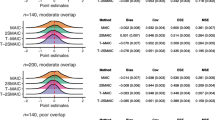Abstract
Estimates of the relative effects of competing treatments are rarely available from head-to-head trials. These effects must therefore be derived from indirect comparisons of results from different studies. The feasibility of comparisons relies on the network linking treatments through common comparators; the reliability of these may also be impacted when the studies are heterogeneous or when multiple intermediate comparisons are needed to link two specific treatments of interest. Simulated treatment comparison and matching-adjusted indirect comparison have been developed to address these challenges. These focus on comparisons of outcomes for two specific treatments of interest by using patient-level data for one treatment (the index) and published results for the other treatment (the comparator) from compatible studies, taking into account possible confounding due to population differences. This paper provides an overview of how and when these approaches can be used as an alternative or to complement standard MTC approaches.

Similar content being viewed by others
Notes
We use the Y(X) notation loosely here to indicate that the response or outcome variable is some function of predictors. We do not intend to imply any specific form or relationship. These are made explicit where needed in the text.
Parameterization used in statistical software can vary. The formula provided here is based on the general form of the Weibull distribution. Analysts should verify the formulation used in the software used to perform the analyses to ensure correct calculation of the HR.
References
Bucher HC, Guyatt GH, Griffith LE, Walter SD. The results of direct and indirect treatment comparisons in meta-analysis of randomized controlled trials. J Clin Epidemiol. 1997;50(6):683–91.
Caldwell DM, Ades AE, Higgins JP. Simultaneous comparison of multiple treatments: combining direct and indirect evidence. BMJ. 2005;331(7521):897–900.
Dias S, Welton NJ, Sutton AJ, Ades AE. NICE DSU technical support document 2: a generalised linear modelling framework for pairwise and network meta-analysis of randomised controlled trials. National Institute for Health and Care Excellence (NICE), Decision Support Unit (DSU), Sheffield. 2011. Last updated April 2014. Available at: http://www.nicedsu.org.uk/TSD2%20General%20meta%20analysis%20corrected%2015April2014.pdf. Accessed 2 Sep 2014.
Hasselblad V. Meta-analysis of multitreatment studies. Med Decis Making. 1998;18(1):37–43.
Lu G, Ades AE. Combination of direct and indirect evidence in mixed treatment comparisons. Stat Med. 2004;23(20):3105–24.
Lumley T. Network meta-analysis for indirect treatment comparisons. Stat Med. 2002;21(16):2313–24.
Sutton AJ, Higgins JP. Recent developments in meta-analysis. Stat Med. 2008;27(5):625–50.
Lu G, Ades AE. Assessing evidence inconsistency in mixed treatment comparisons. J Am Stat Assoc. 2006;101(474):447–59.
Alemayehu D. Assessing exchangeability in indirect and mixed treatment comparisons. Comp Eff Res (Auckl). 2011;1:51–5.
Dias S, Sutton AJ, Welton NJ, Ades AE. NICE DSU technical support document 3: heterogeneity: subgroups, meta-regression, bias and bias-adjustment. National Institute for Health and Care Excellence (NICE), Decision Support Unit (DSU), Shefffield. 2011: Last updated April 2012. Available at: http://www.nicedsu.org.uk/TSD3%20Heterogeneity.final%20report.08.05.12.pdf. Accessed 2 Sep 2014.
Nixon RM, Bansback N, Brennan A. Using mixed treatment comparisons and meta-regression to perform indirect comparisons to estimate the efficacy of biologic treatments in rheumatoid arthritis. Stat Med. 2007;26(6):1237–54.
van Houwelingen HC, Arends LR, Stijnen T. Advanced methods in meta-analysis: multivariate approach and meta-regression. Stat Med. 2002;21(4):589–624.
Caro JJ, Ishak KJ. No head-to-head trial? Simulate the missing arms. Pharmacoeconomics. 2010;28(10):957–67.
Signorovitch JE, Sikirica V, Erder MH, Xie J, Lu M, Hodgkins PS, et al. Matching-adjusted indirect comparisons: a new tool for timely comparative effectiveness research. Value Health. 2012;15(6):940–7.
Signorovitch JE, Wu EQ, Yu AP, Gerrits CM, Kantor E, Bao Y, et al. Comparative effectiveness without head-to-head trials: a method for matching-adjusted indirect comparisons applied to psoriasis treatment with adalimumab or etanercept. Pharmacoeconomics. 2010;28(10):935–45.
Song F, Altman DG, Glenny AM, Deeks JJ. Validity of indirect comparison for estimating efficacy of competing interventions: empirical evidence from published meta-analyses. BMJ. 2003;326(7387):472.
Blinder A. Wage discrimination: reduced form and structural estimates. J Hum Resour. 1973;8(4):436–55.
Fairlie RW. An extension of the Blinder-Oaxaca decomposition technique to logit and probit models. IZA discussion paper no. 1917. J Econ Soc Meas. 2005;30(4):305–16. Available at: http://ftp.iza.org/dp1917.pdf. Accessed 26 Feb 2015.
Oaxaca R. Male-female wage differentials in urban labor markets. Int Econ Rev. 1973;14(3):693–709.
Oaxaca R, Ransom M. On discrimination and the decomposition of wage differentials. J Econom. 1994;61(1):5–21.
Ishak KJ, Kreif N, Benedict A, Muszbek N. Overview of parametric survival analysis for health-economic applications. Pharmacoeconomics. 2013;31(8):663–75.
Tierney JF, Stewart LA, Ghersi D, Burdett S, Sydes MR. Practical methods for incorporating summary time-to-event data into meta-analysis. Trials. 2007;8:16.
Hoyle MW, Henley W. Improved curve fits to summary survival data: application to economic evaluation of health technologies. BMC Med Res Methodol. 2011;11:139.
Acknowledgments
K. Jack Ishak, Irina Proskorovsky, and Agnes Benedict are all employees of Evidera, which provides consulting and other research services to pharmaceutical, device, government, and non-government organizations. In their salaried positions, they work with a variety of companies and organizations and are precluded from receiving payment or honoraria directly from these organizations for services rendered. This manuscript was discussed, written, and edited during their standard work hours and they received their standard salaries from Evidera. Dr. Ishak led the conceptual development, drafting, and review/editing of the paper. Ms. Proskorovsky and Ms. Benedict participated in the conceptual development, drafting, and review/editing of the paper. Dr Ishak will act as the overall guarantor of this work.
The authors wish to thank Connie Chen who provided insights into the applicability of the STC and MAIC methods for indirect comparison in practical situations.
Author information
Authors and Affiliations
Corresponding author
Rights and permissions
About this article
Cite this article
Ishak, K.J., Proskorovsky, I. & Benedict, A. Simulation and Matching-Based Approaches for Indirect Comparison of Treatments. PharmacoEconomics 33, 537–549 (2015). https://doi.org/10.1007/s40273-015-0271-1
Published:
Issue Date:
DOI: https://doi.org/10.1007/s40273-015-0271-1




